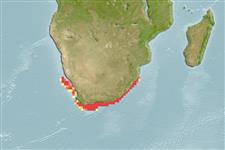Élasmobranches (requins et raies) (sharks and rays) >
Carcharhiniformes (Ground sharks) >
Scyliorhinidae (Cat sharks) > Scyliorhininae
Etymology: Poroderma: poros (Gr.), hole or passage; derma (Gr.), skin or hide, allusion not explained nor evident (Smith proposed name without a description) (See ETYFish); pantherinum: Latin for leopard-like, referring to its variable leopard-like spots, stripes and blotches (See ETYFish).
Environment: milieu / climate zone / depth range / distribution range
Écologie
marin récifal; profondeur 0 - 256 m (Ref. 5578). Subtropical; 28°S - 36°S
Southeast Atlantic: Saldanha to central Natal, South Africa.
Taille / Poids / Âge
Maturity: Lm ? range ? - ? cm
Max length : 84.0 cm TL mâle / non sexé; (Ref. 244); 73.0 cm TL (female)
Description synthétique
Clés d'identification | Morphologie | Morphométrie
Épines dorsales (Total) : 0; Épines anales: 0. A stocky shark with long nasal barbels and a highly variable color pattern of black spots, rings and lines in horizontal rows on a grey to whitish background; white below (Ref. 5578). There are 3 different forms, the typical 'pantherinum' with lines and rosettes of spots, and two extreme forms, 'marleyi' with large dark spots (formerly considered a separate species), and 'salt and pepper' with small, densely packed black spots, intermediates between these extremes are extremely common (Ref. 5578).
Found on or near the bottom of warm-temperate waters, from the intertidal zone to 256 m (Ref. 5578). Prefers rocky reefs (Ref. 5578). Nocturnal (Ref. 244). Feeds on small bony fish, crustaceans, octopus and polychaete worms (Ref. 5578). Oviparous (Ref. 50449). Readily kept in captivity (Ref. 244).
Life cycle and mating behavior
Maturité | Reproduction | Frai | Œufs | Fécondité | Larves
Oviparous, produces one egg per oviduct (Ref. 5578). Embryos feed solely on yolk (Ref. 50449).
Compagno, L.J.V., D.A. Ebert and M.J. Smale, 1989. Guide to the sharks and rays of southern Africa. New Holland (Publ.) Ltd., London. 158 p. (Ref. 5578)
Statut dans la liste rouge de l'IUCN (Ref. 130435: Version 2024-1)
Menace pour l'homme
Harmless
Utilisations par l'homme
Pêcheries: pêcheries vivrières; pêche sportive: oui
Outils
Articles particuliers
Télécharger en XML
Sources Internet
Estimates based on models
Preferred temperature (Ref.
123201): 12.4 - 22.1, mean 16.3 °C (based on 31 cells).
Phylogenetic diversity index (Ref.
82804): PD
50 = 0.7500 [Uniqueness, from 0.5 = low to 2.0 = high].
Bayesian length-weight: a=0.00263 (0.00138 - 0.00502), b=3.21 (3.04 - 3.38), in cm total length, based on LWR estimates for this (Sub)family-body shape (Ref.
93245).
Niveau trophique (Ref.
69278): 4.1 ±0.57 se; based on food items.
Résilience (Ref.
120179): Faible, temps minimum de doublement de population : 4,5 à 14 années (Fec assumed to be <100).
Fishing Vulnerability (Ref.
59153): Moderate to high vulnerability (54 of 100).
Nutrients (Ref.
124155): Calcium = 7.11 [1.51, 36.84] mg/100g; Iron = 0.352 [0.091, 1.024] mg/100g; Protein = 19.2 [16.2, 22.3] %; Omega3 = 0.125 [0.052, 0.290] g/100g; Selenium = 15.6 [4.5, 47.7] μg/100g; VitaminA = 36.5 [12.1, 119.9] μg/100g; Zinc = 0.539 [0.250, 1.132] mg/100g (wet weight);
